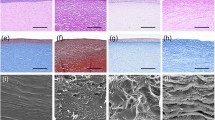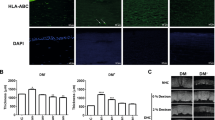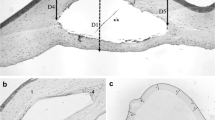Summary
Inverse lamellar keratoplasty was used as a model to investigate whether regenerated corneal epithelium of rabbits produced fibrillar collagen. As the epithelium grew directly on the descemet membrane the evaluation of the origin of newly formed structures between the epithelium and the descemet was facilitated. The epithelium formed several layers on the descemet (Figs. 1 and 2). The endoplasmic reticulum is active mainly in the basal position of the basal cell layer (Figs. 2 and 9). A subepithelial space developed, which widened between the 6th and 12th week after surgery without thinning of the descemet membrane (Figs. 3 and 8). Within this space fibrillar structures 220–250 Å in diameter appeared. Some of these fibrils were striated with a periodicity of 640 Å, typical for native collagen. In addition, the subepithelial space contained granules probably released by epithelial vacuoles (Figs. 10 and 11). A new epithelial basement membrane was formed and almost completely reconstituted after 12 weeks (Figs. 2, 3 and 8). Underneath the descemet there was an accumulation of fibroblastic cells (Fig. 5) rimmed by fine fibrillar material. The cells seem to secrete electron-dense granules (mucopolysaccharides ?) into the descemet membrane (Figs. 4, 6 and 7).
The observations suggest that regenerated epithelium of the rabbit cornea synthesizes both collagenoid proteins for the rebuilding of the basement membrane and native collagen fibrils. A fibrillogenesis by epithelial cells has already been demonstrated in the developing avian cornea and in a case of polymorphous endothelial dystrophy of the human cornea.
Zusammenfassung
Am Modell der inversen lamellierenden Keratoplastik der Kaninchenhornhaut wird untersucht, ob regeneriertes corneales Epithel fibrilläre Kollagenstrukturen bildet. Bei der gewählten Versuchsanordnung wächst das Epithel direkt auf der Descemetschen Membran. Das Verfahren erleichtert die Beurteilung der Herkunft neugebildeter, zwischen Epithel und Descemetscher Membran gelegener Strukturen. Elektronenmikroskopische Präparate werden 6 und 12 Wochen nach dem Eingriff hergestellt. Das Epithel wächst mehrschichtig auf die Descemetsche Membran; es enthält aktive Zellorganellen, besonders im basalen Bereich der untersten Zellschicht. Es entsteht ein subepithelialer Raum, welcher zwischen der 6. und 12. postoperativen Woche deutlich breiter wird ohne gleichzeitige Verdünnung der Descemetschen Membran. In ihm finden sich fibrilläre Strukturen mit einem Durchmesser von 220–250 Å. Teilweise lassen die Fibrillen eine Querstreifung mit der für natives Kollagen typischen Periodizität von 640 Å erkennen. Daneben sind granuläre Strukturen zu sehen. Vermutlich stammen sie aus Epithelvacuolen, die sich in den subepithelialen Raum entleeren. Die epitheliale Basalmembran ist nach 12 Wochen fast vollständig wiederhergestellt. Unterhalb der Descemetschen Membran kommt es zu einer Ansammlung von Fibroblasten. Sie sind von einem Saum feiner Fibrillen umgeben und sezernieren zahlreiche elektronendichte Granula (Mucopolysaccharide?) in die Descemetsche Membran.
Die Beobachtungen lassen vermuten, daß das regenerierte Epithel der Kaninchenhornhaut nicht nur kollagenoide Proteine zur Neubildung seiner Basalmembran, sondern auch Kollagenfibrillen synthetisiert. Eine epitheliale Fibrillogenese wurde bisher in der embryonalen Hühnercornea nachgewiesen, sowie in einem Fall von polymorpher Endotheldystrophie der menschlichen Hornhaut.
Similar content being viewed by others
Literatur
Blümcke, S., Rode, J., Niedorf, H. R.: Formation of the basement membrane during regeneration of the corneal epithelium. Z. Zellforach. 93, 84–92 (1969).
Boruchoff, S. A., Kuwabara, T.: Electron microscopy of posterior polymorphous degeneration. Amer. J. Ophthal. 72, 879–887 (1971).
Cohen, A. M., Hay, E. D.: Secretion of collagen by embryonic neuroepithelium at the time of spinal cord-somite interaction. Develop. Biol. 26, 578–605 (1971).
Gnädinger, M.C.: Synthesis of hydroxyproline in corneal epithelium. Ophthal. Res. 3, 198–206 (1972).
Gnädinger, M. C., Leuenberger, P. M.: Epitheliale Beteiligung an der cornealen Wundheilung. Ber. dtsch. ophthal. Ges. 71, 249–253 (1972).
Gnädinger, M. C., Refojo, M. F., Itoi, M., Berman, M. B.: The epithelium in corneal wound healing. An assay with tritiated proline. Ophthal. Res. 2, 65–76 (1971).
Hay, E. D., Revel, J. P.: Fine structure of the developing avian cornea. In: Monographs in developmental biology, A. Wolsky, P. S. Chen, eds., vol. 1. Basel-New York: Karger 1969.
Kefalides, N. A.: Comparative biochemistry of mammalian basement membranes. In: Chemistry and molecular biology of the intercellular matrix, E. A. Balazs, ed., p. 535–573. New York: Academic Press 1970.
Khodadoust, A. A., Silverstein, A. M., Kenyon, K. R., Dowling, J. E.: Adhesion of regenerating corneal epithelium. Amer. J. Ophthal. 65, 339–348 (1968).
Leuenberger, P. M.: Die Stereo-Ultrastruktur der Cornealoberfläche bei der Ratte. Albrecht v. Graefes Arch. klin. exp. Ophthal. 180, 182–192 (1970).
Leuenberger, P. M., Gnädinger, M. C.: Sur le rôle de l'épithélium dans la cicatrisation cornéenne. Arch. Ophtal. (Paris) 32, 33–42 (1972).
Peterkofsky, B., Udenfriend, S.: Enzymatic hydroxylation of proline in microsomal polypeptide leading to formation of collagen. Proc. nat. Acad. Sci. (Wash.). 53, 335–342 (1965).
Pierce, G. B., Midgley, A. R., Jr., Sriram, J.: Parietal yolk sac carcinoma: clue to the histogenesis of Reichert's membrane of the mouse embryo. Amer. J. Path. 41, 549–566 (1962).
Spiro, R. G.: Biochemistry of basement membranes. In: Chemistry and molecular biology of the intercellular matrix, E. A. Balazs, ed., p. 511–534. New York: Academic Press 1970.
Trelstad, R. L.: The golgi apparatus in chick corneal epithelium: changes in intracellular position during development. J. Cell Biol. 45, 34–42 (1970).
Trelstad, R. L.: Vacuoles in the embryonic chick corneal epithelium, an epithelium which produces collagen. J. Cell Biol. 48, 689–694 (1971).
Trelstad, R. L., Coulombre, A. J.: Morphogenesis of the collagenous stroma in the chick cornea. J. Cell Biol. 50, 840–858 (1971).
Author information
Authors and Affiliations
Additional information
Diese Arbeit wurde durch den Schweizerischen Nationalfonds zur Förderung der wissenschaftlichen Forschung, Kredit Nr. 3.300.70 unterstützt.
Rights and permissions
About this article
Cite this article
Leuenberger, P.M., Gnädinger, M.C. & Cabernard, E. Zur Frage der Kollagensynthese durch corneales Epithel. Albrecht von Graefes Arch. Klin. Ophthalmol. 187, 171–182 (1973). https://doi.org/10.1007/BF00531116
Received:
Issue Date:
DOI: https://doi.org/10.1007/BF00531116




